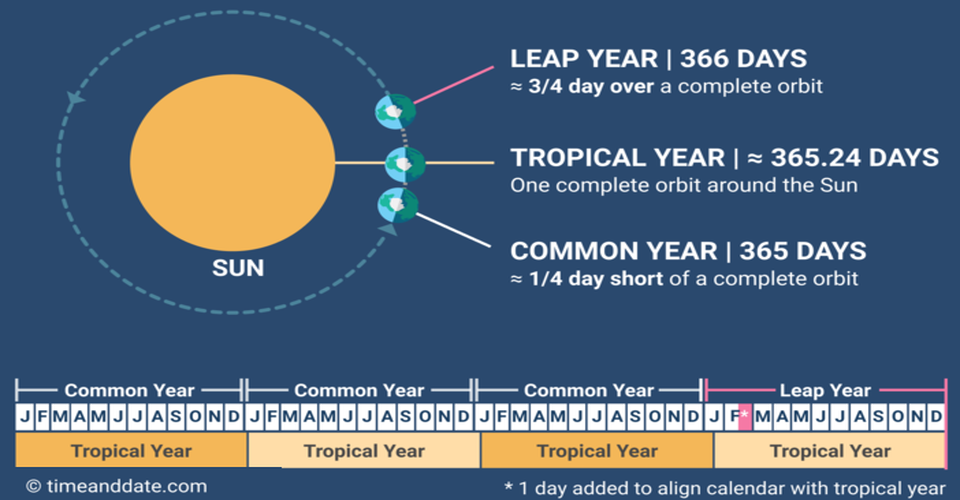29th February - Leap Year Day
Written by Anne Newman 24th February 2020 with additions 2023
April, June and November, All the rest have 31, Excepting February once in four, Has 29, one day more. |
29th February, also known as Leap Day or Leap Year Day, is a date added to most years that are divisible by 4. Years containing a Leap Day are called Leap Years.
Why do we have Leap Years?
A complete revolution around the Sun (one solar year) takes approximately 365 days and 6 hours. An extra 24 hours thus accumulates every four years, requiring that an extra calendar day be added to align the calendar with the Sun's apparent position.
Until Julius Caesar came to power, people observed a 355-day calendar - with an extra 22-day month every two years. But it was a convoluted solution to the problem and feast days began sliding into different seasons. So Caesar ordered his astronomer, Sosigenes, to simplify things. Sosigenes opted for the 365-day year with an extra day every four years to scoop up the extra hours. This is how the 29th February was born.
Every fourth year is a leap year, as a rule of thumb. But that's not the end of the story. A year that is divisible by 100, but not by 400, is not. So 2000 was a leap year under the Gregorian calendar, as was 1600. But 1700, 1800 and 1900 are not leap years.

| About fifty years ago, people believed in a day called "La Corr Na Bliana". It was believed that ill-luck would come to any person who transacted business on this particular day. This day fell on a Monday, every week for one year, on a Tuesday the next year, and so on. In the case of a Leap Year, one day was skipped. La Corr Na Bliana - Odd Day of the Year |
Leap Year Babies
A person born on 29th February may be called a "leapling", a
"leaper", or a "leap-year baby". In non-leap years, some leaplings
celebrate their birthday on either 28th February or 1st March, while
others only observe birthdays on the authentic date, 29th February.
People born on 29th February are all invited to join The Honour Society of Leap Year Day Babies. Founded in 1997, it's currently over 10,000 members strong. The odds of being born on 29th February are 1 in 1,461, or .068 per cent. That makes them a real minority, with only about five million Leaplings in the whole world.

Leap Day World Record Holders
A family in Norway managed to welcome three children on different Leap Days, each four years apart. Karin and Henry Henriksen had three children and each defied the odds. Heidi, the eldest, was born on 29th February, 1960. Olav, the next, was born February 29, 1964. And Leif-Martin, the youngest, was born in 1968. The trio nabbed the record for most siblings born on the same day.
A Utah family also has three children born on Leap Day. Louise Estes welcomed Xavier born in 2004, Remington in 2008, and Jade in 2012. Two Generations born on 29th February Michelle Birnbaum from Saddle River, New Jersey was born on 29th February, 1980. In 2008, she gave birth to a daughter named Rose.
Born and Died on 29th February
Sir James Milne Wilson was the Premier of Tasmania from 1869 to 1872. While that was certainly an accomplishment, the most impressive thing about him was that he was born on 29th February, 1812 and died on 29th February, 1880, making him one of the only known people to have been born on and die on a Leap Day.
In Scotland, it was also to be considered unlucky for someone to be born on leap day.
Bachelor's Day
There is a popular tradition known as Bachelor's Day in some countries allowing a woman to propose marriage to a man on 29th February. If the man refuses, he is then obliged to give the woman money or buy her a dress. In upper-class societies in Europe, if the man refuses marriage, he then must purchase 12 pairs of gloves for the woman, suggesting that the gloves are to hide the woman's embarrassment of not having an engagement ring.
During the middle ages there were laws governing this tradition. In Ireland, there is an old Irish legend, that St Brigid struck a deal with St Patrick to allow women to propose to men – and not just the other way around – every four years. It began in 5th century Ireland when St. Brigid of Kildare bitterly complained to St. Patrick that women had to wait far too long for men to propose. The legend says that St. Patrick decreed the women could propose on this one day in February during the leap year. The tradition was then taken to Scotland by Irish monks. Back in 1288, the Scots passed a law that allowed a woman to propose marriage to the man of their dreams in a leap year, with the law also stating that any man who declined the proposal on this day would have to pay a fine.
Greeks consider it unlucky for couples to marry during a leap year, and especially on Leap Day.
In the town of Aurora, Illinois, single women are deputized and may arrest single men, subject to a four-dollar fine.
St Oswald of Worcester
Leap day is also St Oswald’s Day, an Archbishop of York who died on 29th February, 992. His memorial is celebrated on 29th February during leap years and on 28th February on other years.
Oswald was widely known for his sanctity, especially his love for the poor. The final winter of his life was spent at the cathedral in Worcester that he so loved. At the start of Lent, he resumed his usual practice of washing the feet of 12 poor men each day. On Leap Year Day, February 29, he died after kissing the feet of the 12th man and giving a blessing. St. Oswald information
Clew Bay, Mayo - Rostellan Castle, Cork - Geeragh, Cork
In Clew Bay there are three hundred and sixty five islands - one for each day in the year. The old people say that if you counted the islands in a leap-year there would be three hundred and sixty six. from Duchas Schools Collection - Westport, Mayo
During my holidays last year I visited Rostellan Castle, which is some distance from Midleton. This Castle is of an enormous height, and has three hundred and sixty six windows, one for every day in the year. One of the windows was closed or darkened when the calendar was changed from three hundred and sixty six days to three hundred and sixty five. Rostellan Castle, Duchas Schools Project
Gaorba, or Garra (Geeragh) appears from the road to be nothing more than a wood along the bottom of the valley, with a stream running at its side. It is one of the most unique bits of scenery in the world. The river here subdivides into a maze of streamlets, each two or three yards wide, there being one, it is said, for every day in the year, with one extra for leap year. The islets many of which are about the size of a billiard table, are covered with timber (chiefly oak), the boughs join over the little streamlets, thus forming a most agreeable shade. Details in this Irish Times article






